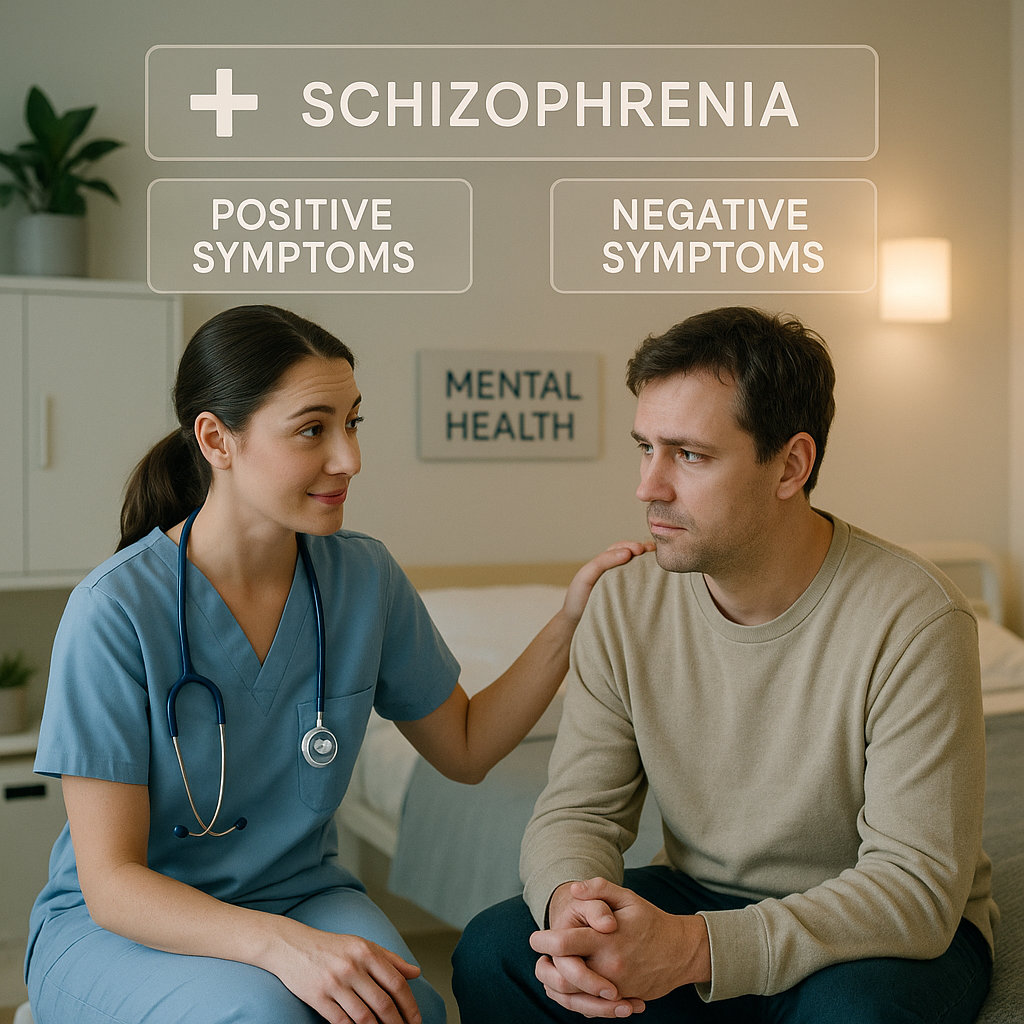Understanding schizophrenia is essential for every nurse preparing for the NCLEX or working in mental health. This complex disorder affects how a person thinks, feels, and behaves — often leading to a loss of contact with reality.
In nursing practice, distinguishing between positive and negative symptoms helps the registered nurse (RN) plan appropriate interventions, provide therapeutic communication, and ensure patient safety.
This guide breaks down the basics and offers NCLEX-focused tips for every nursing student or RN nurse.
🔍 What Is Schizophrenia?
Schizophrenia is a chronic psychiatric disorder marked by psychosis, where individuals may experience hallucinations, delusions, and disorganized thinking.
For the nurse, the focus is on maintaining safety, medication compliance, and effective communication.
The cause is multifactorial — genetics, brain chemistry (dopamine imbalance), and environmental stressors all play roles.
💬 Positive Symptoms of Schizophrenia
Positive symptoms add behaviors or experiences not normally present.
Think of these as “things that shouldn’t be there.”
Common Positive Symptoms:
- Hallucinations – Perceiving things that aren’t real (most commonly hearing voices).
- Delusions – False, fixed beliefs (e.g., thinking they’re being watched or controlled).
- Disorganized speech – Jumping between topics, incoherent conversation.
- Bizarre behavior – Unpredictable actions, agitation, or inappropriate affect.
Nursing Tips:
- Don’t argue or reinforce delusions; instead, acknowledge the feeling.
- Use clear, calm communication.
- Maintain safe distances if the patient is agitated.
- Focus on reality orientation gently.
Example (for NCLEX):
A patient says, “The FBI implanted a chip in my head.”
The correct nurse response is:
“That sounds frightening. I don’t see any evidence of a chip, but I know this feels real to you.”
🕊️ Negative Symptoms of Schizophrenia
Negative symptoms remove normal emotional and behavioral functions —
these are “things that are missing.”
Common Negative Symptoms:
- Alogia – Limited or absent speech.
- Affect flattening – Dull emotional expression.
- Avolition – Lack of motivation or goal-directed activity.
- Anhedonia – Inability to feel pleasure.
- Social withdrawal – Avoiding interaction and isolation.
Nursing Tips:
- Use simple, one-step instructions.
- Encourage self-care and social engagement gradually.
- Avoid pushing; patience and consistency matter.
- Reinforce routine and structure to reduce anxiety.
Example (for NCLEX):
A patient sits silently and avoids eye contact.
The nurse’s best action:
Sit quietly nearby and offer presence — therapeutic silence promotes trust.
💊 Nursing Interventions and Medications
Antipsychotic medications are key in managing schizophrenia.
There are two major classes:
1. Typical (First-Generation) Antipsychotics
- Example: Haloperidol (Haldol), Chlorpromazine (Thorazine)
- Treat positive symptoms effectively.
- Watch for: Extrapyramidal symptoms (EPS), tardive dyskinesia, and neuroleptic malignant syndrome (NMS).
2. Atypical (Second-Generation) Antipsychotics
- Example: Risperidone (Risperdal), Olanzapine (Zyprexa), Clozapine (Clozaril)
- Treat both positive and negative symptoms.
- Monitor: WBC counts (especially with clozapine), weight gain, metabolic syndrome.
RN nurse tip: Always check medication adherence, as stopping antipsychotics can trigger relapse — a key NCLEX concept.
🧩 Nursing Priorities for Schizophrenia
- Safety first – Prevent self-harm or aggression.
- Medication compliance – Reinforce the importance of regular dosing.
- Therapeutic communication – Listen without judgment; avoid confrontation.
- Promote social skills – Encourage group therapy and structured activities.
- Education – Teach families about early relapse signs (e.g., social withdrawal, poor hygiene).
The nursing bundle for psychiatric care should always include schizophrenia education and medication teaching guides.
💡 NCLEX Tip
For NCLEX questions, remember:
- Positive = Additions (hallucinations, delusions)
- Negative = Subtractions (flat affect, lack of motivation)
- Always prioritize safety, medication compliance, and therapeutic communication.
🧠 Summary Table
| Type | Example Symptoms | Nursing Focus |
|---|---|---|
| Positive | Hallucinations, delusions, disorganized speech | Reality orientation, calm communication |
| Negative | Flat affect, avolition, alogia | Encourage self-care, structured environment |
✅ Key Takeaways for Nursing Students
- Recognize positive vs negative symptom differences.
- Know your antipsychotic medication side effects.
- Practice therapeutic communication techniques.
- Safety, structure, and consistency are vital in nursing care.
- Review schizophrenia in your nursing bundle for quick NCLEX prep.
🩺 FAQs – Schizophrenia Nursing: Positive vs Negative Symptoms
Positive symptoms are additions to normal behavior — they include hallucinations, delusions, disorganized speech, and bizarre behavior.
For NCLEX nurses, remember that “positive” means something extra is present that shouldn’t be. These symptoms often respond well to antipsychotic medications.
Negative symptoms involve the loss of normal functions — such as flat affect, social withdrawal, lack of motivation, and poor speech (alogia).
As a registered nurse, focus on encouraging social interaction, consistent routines, and emotional support.
Use therapeutic communication — speak calmly, use simple and clear language, and avoid arguing about delusions.
For NCLEX-style questions, remember: “Acknowledge feelings, not the hallucination.” Example: “I understand that must feel frightening.”
Antipsychotic medications are the main treatment.
Typical (first-generation): Haloperidol, Chlorpromazine
Atypical (second-generation): Risperidone, Clozapine, Olanzapine
Nurses should monitor for extrapyramidal side effects (EPS), neuroleptic malignant syndrome (NMS), and metabolic syndrome.
Maintain safety (for patient and others)
Establish trust and consistent communication
Encourage medication compliance
Monitor for suicidal ideation
Promote social skills and daily routines

